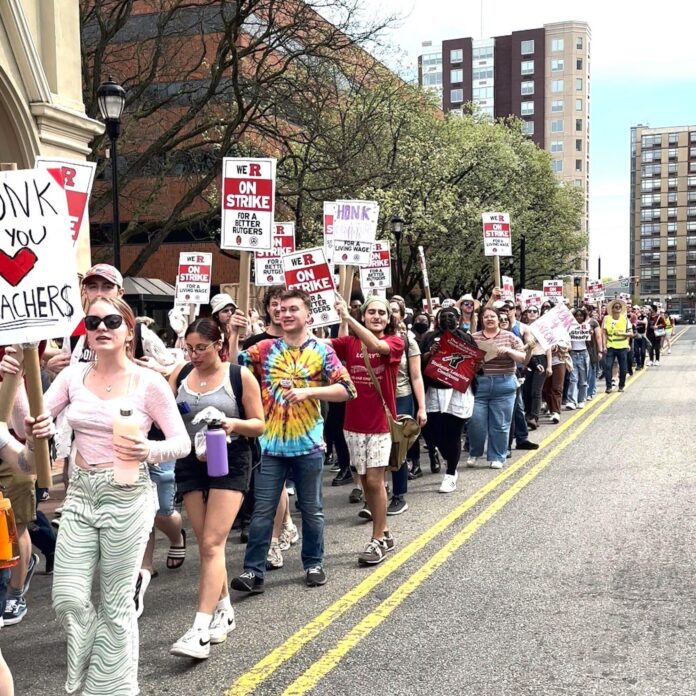Around 9,000 workers at New Jersey’s state university, Rutgers University—including professors, part-time lecturers and graduate students—have been on strike since 10 April. This marks the first time in the university’s 257-year history that a labour action this large has taken place. The strike is now in its third day and spans the university’s multiple campuses across the state, where more than 67,000 students are enrolled.
Despite picket lines at three of the Rutgers campuses—its main hub in New Brunswick as well as campuses in Newark and Camden—classes are still being held according to the school’s website. However, several media outlets have reported that some classes have been canceled. The strike comes after nearly 11 months of contract negotiations between the university’s leadership and three unions representing its employees.
“The picket has brought together faculty and students—standing together—fighting for what is right! The picket has tons of positivity,” says Tom Raggio, a visual art professor at the university’s Mason Gross School of the Arts. “It’s a very creative and fun time, colleagues are talking to each other (some for the first time), debunking misleading information, educating how we even got to this point and having important discussions that will bond us forever.”
A spokesperson for the university’s Zimmerli Art Museum, located on the New Brunswick campus, had not responded to a request for comment as of press time, but the museum appears to be open despite the strike. The university’s administrative offices, buildings, labs and libraries also remain open.
“We are also fighting for students and the community in the form of housing justice and a Rutgers-supported Beloved Community Fund for local residents who experience or have experienced financial and other hardships and have been excluded from other state or federal relief program,” says David Letwin, a professor at the Mason Gross School of the Arts and an executive board member of the university’s American Association of University Professors and American Federation of Teachers (AAUP-AFT), who has been a part of the negations.
Current faculty at the Mason Gross School of the Arts includes the visual artist Didier William, photographer Mark Mcknight and conceptual artist Park McArthur, among others. The decision to go on strike was made official on the night of 9 April after a 94% majority vote was reached with all three of the unions that represent academic staff across the university. The unions include the Rutgers AAUP-AFT, which consists of full-time faculty, graduate workers postdoctoral associates and other workers; the Rutgers Adjunct Faculty Union is comprised of part-time lecturers and the American Association of University Professors–Biomedical and Health Sciences of New Jersey (AAUP-BHSNJ) represents faculty across the university’s medical, dental, nursing and public health schools.
As of the evening of 11 April, union representatives were still in bargaining sessions with school administrators. The two sides remain far apart on many issues, including equal pay for equal work for adjunct faculty, guaranteed funding and a living wage for graduate workers, job security for all faculty, a fair salary increase commensurate with inflation, affordable housing for students and forgiveness for students’ overdue fees and fines.
As Rutgers is the state university of New Jersey, there is also pressure coming from the office of Governor Phil Murphy to quickly resolve the strike. According to a university spokesperson, Murphy called on all parties to meet at the statehouse in Trenton yesterday (11 April).
“We are encouraged and welcome his leadership and are hopeful that we can quickly come to a resolution of the remaining outstanding issues,” the spokesperson says. “This is all very fluid and we expect evolving proposals as we negotiate at the statehouse over the coming days. The Governor also asked us to delay taking legal action asking the courts to order strikers back to work so that no further irreparable harm is caused to our students and to their continued academic progress.”
Last week, the school released guidance for students in anticipation of the strike, including addressing the possibility that the state might resort to legal action to end the strike. “The university may go to court to maintain university operations and protect our students, patients and staff from disruptions to their education, clinical care and workplace,” the Rutgers FAQ page states. “The university may seek an injunction in court to compel a return to normal activities.”
The strike comes amid a wave of union organising at art colleges and universities in the US, as well as museums and other cultural institutions. Last December, nearly 48,000 unionised workers at the University of California went on a strike that lasted almost 6 weeks. This also coincided with a strike at the New School and Parsons School of Design in New York, which became the longest of its kind staged by adjunct faculty in US history. The New School strike, which lasted three weeks, virtually shut the school down because almost 90% of the school’s faculty is made up of untenured lecturers and professors.
“The broader context for the strike is the growth of the corporate university and the exploitation, precarity, and contingency that goes along with it,” says Letwin. “These issues go far beyond Rutgers. Whether it’s other academic and K-12 strikes or unionizing efforts at Starbucks and Amazon, our struggle is part of the broader fight for economic and employment justice.”

























